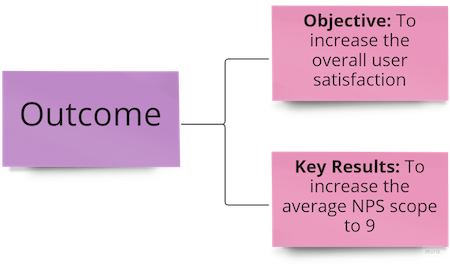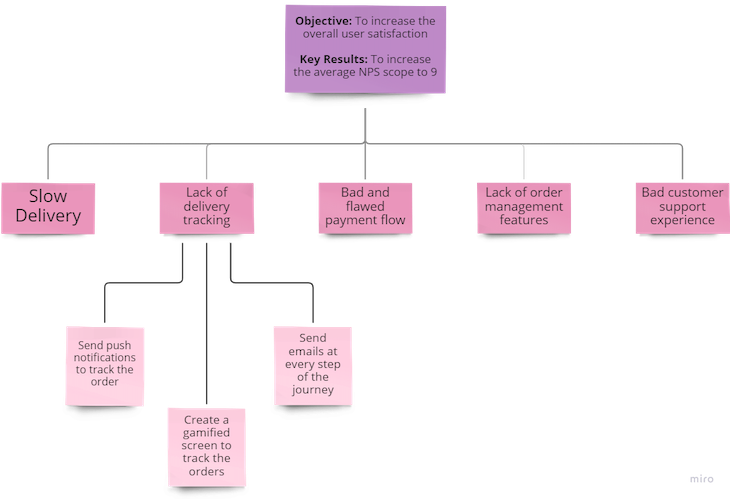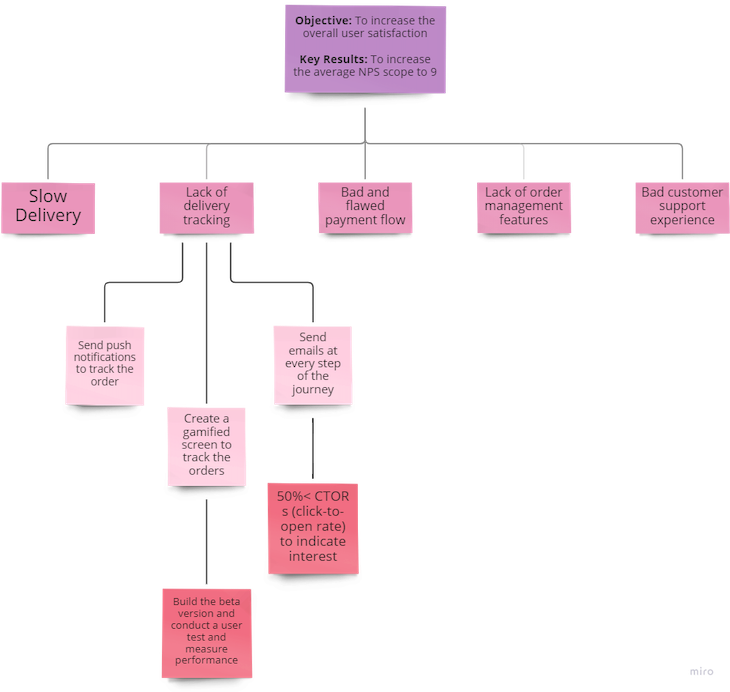Everything starts with product discovery. Whether you want to build a completely new, innovative feature or solve an existing simple problem, product discovery is the first step.

Product discovery helps product teams dig deeper into the users’ problems, empathize with them, ideate around them, and reach the best possible solution.
Product discovery is conducted using a variety of techniques, workshops, and methods, one of them being the opportunity solution tree (OST) approach. An OST is designed to help product teams generate the best possible solutions (called opportunities) to the problems their users face.
In this guide, we’ll dig deeper into the art of the OST and teach you, in a robust and simple way, how to build one and align your product team around it.
An opportunity solution tree is a discovery visualization tool designed to help product teams determine the best path to achieve a desired outcome. An OST also helps PMs communicate this desired outcome along with the potential obstacles and strategies to overcome them.
An opportunity solution tree aims to link the ultimate outcome, which is driven by user problems or a product vision, and the problems that prevent the product team from reaching the desired outcome (opportunities) with their possible solutions. It also outlines experiments to validate whether the solution helps to solve the problem and achieve the outcome.
A typical opportunity solution tree looks something like this:

You can use the OST framework above as a template when creating your own opportunity solution tree.
Teresa Torres invented the opportunity solution tree in 2016. Since then, the OST has been adopted by many companies across the globe.
Torres designed the opportunity solution tree to:
Among the many benefits of adopting the approach for product management, opportunity solution trees empower product teams to:
Whenever your team comes up with an idea, it has to be linked back to the business goal. This will help your team focus on the outcome, which is framed around the product vision and strategy.
Secondly, most of the product discovery sessions that involve the use of an OST have at least a designer, an engineer, and a product manager in attendance. Each role proposes solutions for opportunities.
The product manager typically links the idea back to the outcome and product strategy. The designer explains this from the user experience perspective and shares some qualitative user insights about it. Then, the engineer shares more in-depth cases with the team and helps estimate the technical feasibility of the desired outcome.
This process helps the team shortlist and prioritize only the most feasible ideas for the validation stage and, ultimately, execution.
Every solution prioritized using an OST must be validated and researched before advancing to the execution stage.
This means that, when you are conducting research, you have a research backlog full of tasks that will eventually help you reach your outcome faster.
With the OST’s top-down approach, you’ll be driven by the business outcome, discovering opportunities, and ideating features with your team using your qualitative and quantitative data insights.
The last step is to prioritize the solutions and plan experiments to validate them before execution. The OST cycle provides the context your team needs to ensure that each developed feature has a solid, logical story that stakeholders can align with.
Creating an opportunity solution tree can be fairly simple. If you’re looking to adopt the OST model as a method of visualizing your product discovery thoughts, follow the steps outlined below:
To create a successful OST, start by identifying the outcomes needed for the business. Many companies nowadays use objectives and key results (OKRs) to help them identify outcomes — to learn more, check out “What are OKRs and how to write them (with templates and examples).”
Align with your team to understand the user problems from their perspective. You should also conduct open-ended user interviews to understand their perspective on the outcome.
Once you have all the data, you can start creating the outcome that you will work toward achieving. The outcome should always be quantifiable; this will help you in the validation process later on.
Let’s look at an example to demonstrate the process of building an opportunity solution tree. The example is for a B2B marketplace that has an average NPS score of 6.
The company knows that an average NPS of 6 means that most of its customers are detractors. They also know that a low NPS can affect retention in the long run.
The company wants to shoot for the moon by increasing its NPS to 9 and moving its user base of 100k customers to promoters. The product manager worked with the leadership and the team to set the outcome needed for the final quarter of the year 2022.
Here’s the outcome they ended up with:

Now that you have the outcome defined, you and your product team should start gathering qualitative and quantitative user insights to understand the obstacles to achieving the outcome.
The opportunities can be problems with the product or completely new areas that have yet to be discovered but still fall under the umbrella of the product vision and strategy.
Going back to our OST example from above, the product manager gathers the product team and other important stakeholders in a brainstorming session. They discuss the user insights and the problems their customers face. Now they are ready to identify opportunities that might help them increase the average NPS to 9.
After the first half of the brainstorming is done, they end up with a set of prioritized opportunities they think affects the NPS score negatively:

Once you identify solutions, the product team can decide on how many opportunities they want to pursue at once.
Once the opportunities are picked, the team can start brainstorming ideas around the opportunities. There is no limit to the ideas; they can be influenced by competitors, other markets, customer suggestions, or even personal ideas.
Going back to our example, the team thinks the most crucial opportunity is the lack of delivery tracking because it is an essential feature for marketplaces. The team along, with the product manager, decide to pursue this opportunity for one sprint and validate whether it archives the outcome.
With the following solutions ideated, they are now ready for the final step:

Once the opportunity is chosen and many solutions identified, the product team can start experimenting with those solutions.
The team agrees on the experimentation methods and expected results that need to be proven, validated, and annotated in the OST to link it to the outcome.
For our example, the team decides to prioritize testing the last two solutions to see how they might affect the outcome. The team plans two different experimentation methods and ends up with this OST view:

If you’re considering using opportunity solution trees in your organization, keep the following tips in mind:
Some problems have crystal-clear solutions. In those cases, you don’t need to go through extensive product discovery or use an opportunity solution tree; you can bypass this stage and move straight to execution.
Before gathering your team, ideating together, and, eventually, building an OST, you should have a clear reason why you need to ideate and use the opportunity solution tree.
You can’t use the OST model alone; doing so would cancel out the benefits it was designed to deliver.
You should always have at least a designer and an engineer with you during the discovery meeting. Also be sure to keep the other product team members and the organization informed of the results and the action points.
Normally, an OST acts as a tool to help you generate action plans. After the discovery session, you will come up with different solutions for different opportunities (aka problems).
Each solution will have a validation technique to validate whether it can help your team achieve the intended outcome. Be sure to always have a clear plan, including a timeline on when to start the testing and validation phase and who will own each initiative.
When it comes to learning the opportunity solution tree method and digging deeper into its use cases, there is no better resource than the founder of this technique, Teresa Torres.
Torres, the founder of Product Talk Academy, has launched a pair of excellent resources to help you master the art of the opportunity solution tree:
In this live, online class, Torres takes product managers and teams on a journey of learning various methods to create feedback loops that aid assumption-validation and decision-making.
The class touches on the opportunity solution tree through examining three real-world case studies and how the OST helped their product teams run effective ideation and test assumptions.
Continuous Discovery Habits is the bible when it comes to effective product discovery techniques. The book teaches product teams how to be outcome-driven rather than a feature factory. It also dives into the art of discovering problems, testing assumptions, and ideating solutions closely with customers and visualizing and grouping those ideas using the opportunity solution tree framework.
Since the opportunity solution tree was invented, it has proven to be successful for many product teams around the world. Using opportunity solution trees can help you examine your thinking through a clear and defined quantitative outcome driven by an OKR, followed by opportunities and, finally, the solution and a validation experiment for each opportunity.
Featured image source: IconScout

LogRocket identifies friction points in the user experience so you can make informed decisions about product and design changes that must happen to hit your goals.
With LogRocket, you can understand the scope of the issues affecting your product and prioritize the changes that need to be made. LogRocket simplifies workflows by allowing Engineering, Product, UX, and Design teams to work from the same data as you, eliminating any confusion about what needs to be done.
Get your teams on the same page — try LogRocket today.

A practical five minute revenue estimation method to help product managers compare ideas, drop low impact features, and prioritize smarter.

A practical guide for PMs who want to stop being bottlenecks, delegate smarter, and lead teams effectively with a clear ownership framework.

Stop letting unreliable data block features. Treat data as inventory to track quality, ownership, and ship with confidence.

Learn why slide decks slow teams down and explore better tools like whiteboards, PRDs, and prototypes to improve collaboration and alignment.
2 Replies to "Opportunity solution trees: Definition, examples, and how-to"
Thank you very much for this helpful article! 🙂
Appreciate your feedback 🙂